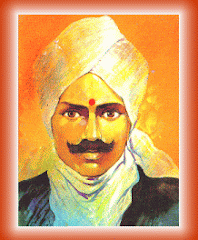The Miracle Tree! - MURUNGAI MARAM!
|C.S Baskaran
Moringa Oleifera : The Miracle Tree
Moringa is known in 82 countries by 210 different names, but the one name that fully encompasses all its attributes is "the Miracle Tree".
The indigenous knowledge and use of Moringa Oleifera is
referenced in more than 80 countries and known in over 200 local
languages. Moringa has been used by various societies (Roman, Greek,
Egyptian, and Indian to mention a few) for thousands of years with
writings dating as far back as 150 AD.
Botanical Name: MORINGA OLEIFERA
Family Name: MORINGACEAE
Common Name: MORINGA, HORSE RADISH TREE, DRUMSTICK TREE, SAHIJAN
Part Used: ROOTS, SEEDS, LEAVES
Habitat: Found Through out India.
Uses: The roots are acrid, digestive, antihelmentic, constipating,
anodyne, bitter alexipharmic stimulant and vesicant. They are useful in
paralysis, inflammations, fever, cough, cold, bronchitis, pectoral
diseases, epilepsy, hysteria. its leaves are useful in scurvy, vitiated
conditions of kapha and vata. The seeds are acrid, bitter, anti
inflammatory, purgative, and are useful in neuralgia, inflammations and
intermittent fever.
Moringa Oleifera Nutritional Facts
7 times the vitamin C found in oranges
Vitamin C strengthens our immune system and fights infectious diseases
including colds and flu. Citrus fruits such as oranges and lemons are
full of vitamin C. Moringa leaves have even more.
4 times the calcium found in milk
Calcium builds strong bones and teeth, and helps prevent osteoporosis.
Milk provides a lot of calcium, but Moringa leaves provide even more.
4 times the Vitamin A found in carrots
Vitamin A acts as a shield against diseases of the eyes, skin and heart,
diarrhea, and many other ailments. Carrots are very high in vitamin A,
with Moringa leaves even higher.
3 times the potassium found in bananas
Potassium is essential for the brain and nerves. Bananas are an excellent
source of potassium. Moringa leaves are even better.
2 times the protein found in yogurt
Proteins, the building blocks of our bodies, are made of amino acids.
Usually only animal products such as meat, eggs, and dairy contain all
the essential amino acids. Amazingly, Moringa leaves also contain them
all.
75 times the iron found in spinach
Iron is an essential nutrient because it's a central part of hemoglobin
in blood which carries oxygen to all parts of the body. Spinach is well
known for its iron content. Moringa leaves also contain iron.
Thursday, September 24, 2009
Saturday, September 12, 2009
BRAIN DAMAGING HABITS.....!!!
Sep 13, 2009 at 8:25 AM, Sithamparapzillai Kathieravelu :
BRAIN DAMAGING HABITS
1. No Breakfast
People who do not take breakfast are going to have a lower blood sugar level. This leads to an insufficient supply of nutrients to the brain causing brain degeneration.
2 . Overeating
It causes hardening of the brain arteries, leading to a decrease in mental power.
3. Smoking
It causes multiple brain shrinkage and may lead to Alzheimer disease.
4. High Sugar consumption
Too much sugar will interrupt the absorption of proteins and nutrients causing malnutrition and may interfere with brain development.
5. Air Pollution
The brain is the largest oxygen consumer in our 20 body. Inhaling polluted air decreases the supply of oxygen to the brain, bringing about a decrease in brain efficiency.
6 . Sleep Deprivation
Sleep allows our brain to rest.. Long term deprivation from sleep will accelerate the death of brain cells..
7. Head covered while sleeping
Sleeping with the head covered increases the concentration of carbon dioxide and decrease concentration of oxygen that may lead to brain damaging effects.
8. Working your brain during illness
Working hard or studying with sickness may lead to a decrease in effectiveness of the brain as well as damage the brain.
9. Lacking in stimulating thoughts
Thinking is the best way to train our brain, lacking in brain stimulation thoughts may cause brain shrinkage.
10. Talking Rarely
Intellectual conversations will promote the efficiency of the brain
by Sithamparapzillai
BRAIN DAMAGING HABITS
1. No Breakfast
People who do not take breakfast are going to have a lower blood sugar level. This leads to an insufficient supply of nutrients to the brain causing brain degeneration.
2 . Overeating
It causes hardening of the brain arteries, leading to a decrease in mental power.
3. Smoking
It causes multiple brain shrinkage and may lead to Alzheimer disease.
4. High Sugar consumption
Too much sugar will interrupt the absorption of proteins and nutrients causing malnutrition and may interfere with brain development.
5. Air Pollution
The brain is the largest oxygen consumer in our 20 body. Inhaling polluted air decreases the supply of oxygen to the brain, bringing about a decrease in brain efficiency.
6 . Sleep Deprivation
Sleep allows our brain to rest.. Long term deprivation from sleep will accelerate the death of brain cells..
7. Head covered while sleeping
Sleeping with the head covered increases the concentration of carbon dioxide and decrease concentration of oxygen that may lead to brain damaging effects.
8. Working your brain during illness
Working hard or studying with sickness may lead to a decrease in effectiveness of the brain as well as damage the brain.
9. Lacking in stimulating thoughts
Thinking is the best way to train our brain, lacking in brain stimulation thoughts may cause brain shrinkage.
10. Talking Rarely
Intellectual conversations will promote the efficiency of the brain
by Sithamparapzillai
Thursday, September 10, 2009
An open letter to all those dealing with Human Rights, Workers’ Rights and Women’s Rights...!!!
An open letter to all those dealing with
Human Rights, Workers’ Rights and Women’s Rights
In 2003 Women’s Education & Research Centre (WERC) did a survey of the Domestic Servants employed in Colombo. And having realised the injustice done to them by the System of Recruitment and the general treatment given to them by their employers, we met a host of people including the Ministers of Labour and other concerned groups and brought to the attention of the ILO and some Trade Unions.
However, no one except the National Workers Congress paid any attention to the issue, and the system continues till today without any amelioration procedures or processes. The general apathy of the political and the civil society continue unashamedly. And what is the consequence?
Today we hear of the deaths of the two under-aged domestic servants.
How many more deaths do we have to count?
Will the authorities who have the power to make and amend laws listen to us at least now? We reproduce below what we published in the media and sent to persons and organisations in 2003.
* Registration of Domestic Aides with the Department of Labour by employers, who shall keep the department informed of changes in the place of employment of those registered, to be made compulsory with a fine of Rs. 20,000/= for failure to do so.
* Domestic Service to be regulated by contract as full, part-time or on hourly basis with social benefits accruing to each category.
* EPF and ETF to apply to Domestic Aides
* Leave entitlement of Domestic Aides should be determined. E.g:
1) One Day a week/total of 30 days per annum
2) Sick/medical leave
3) Maternity leave
* Minimum wage of Rs. 3,500= per month, subject to higher actual wage negotiated between employer and Domestic Aides leading to a contractual agreement as envisaged at 2 above
* If employment is full-time, a rest period of 2 hours, twice a day should be provided
* Privacy ensured – provision of separate sleeping area and bath and toilet facilities
* Employers permit normal interaction with visiting family members, provided the letter has indicated their relationship and frequency of visits mutually agreed upon.
The age of the domestic servants, we feel, should be the concern of any authority and institution that have to monitor the recruitment procedures.
We have now two Ministers in the present regime who are from the Left Movement of the Old Left. Do they still want to help the working class of their country or have they abdicated working class interests and want to reform the Capitalist System?!
Dr. Selvy Thiruchandran
On behalf of WERC
www island.lk
Human Rights, Workers’ Rights and Women’s Rights
In 2003 Women’s Education & Research Centre (WERC) did a survey of the Domestic Servants employed in Colombo. And having realised the injustice done to them by the System of Recruitment and the general treatment given to them by their employers, we met a host of people including the Ministers of Labour and other concerned groups and brought to the attention of the ILO and some Trade Unions.
However, no one except the National Workers Congress paid any attention to the issue, and the system continues till today without any amelioration procedures or processes. The general apathy of the political and the civil society continue unashamedly. And what is the consequence?
Today we hear of the deaths of the two under-aged domestic servants.
How many more deaths do we have to count?
Will the authorities who have the power to make and amend laws listen to us at least now? We reproduce below what we published in the media and sent to persons and organisations in 2003.
* Registration of Domestic Aides with the Department of Labour by employers, who shall keep the department informed of changes in the place of employment of those registered, to be made compulsory with a fine of Rs. 20,000/= for failure to do so.
* Domestic Service to be regulated by contract as full, part-time or on hourly basis with social benefits accruing to each category.
* EPF and ETF to apply to Domestic Aides
* Leave entitlement of Domestic Aides should be determined. E.g:
1) One Day a week/total of 30 days per annum
2) Sick/medical leave
3) Maternity leave
* Minimum wage of Rs. 3,500= per month, subject to higher actual wage negotiated between employer and Domestic Aides leading to a contractual agreement as envisaged at 2 above
* If employment is full-time, a rest period of 2 hours, twice a day should be provided
* Privacy ensured – provision of separate sleeping area and bath and toilet facilities
* Employers permit normal interaction with visiting family members, provided the letter has indicated their relationship and frequency of visits mutually agreed upon.
The age of the domestic servants, we feel, should be the concern of any authority and institution that have to monitor the recruitment procedures.
We have now two Ministers in the present regime who are from the Left Movement of the Old Left. Do they still want to help the working class of their country or have they abdicated working class interests and want to reform the Capitalist System?!
Dr. Selvy Thiruchandran
On behalf of WERC
www island.lk
Animals mourn loss of near and dear ones....!!!
Animals mourn loss of near and dear ones
Imagine your child dead or lost. The shock, horror, the feeling of helplessness and grief.
Grief is a reaction to the absence of something or someone who caused happiness, comfort. The continued absence of that person or thing can lead to stress. In the context of bereavement, this stress is termed grief. Charles Darwin, the great scientist, wrote that animals share our emotions including grief.
People like to believe that animals have no sense of their mortality and are unable to comprehend the concept of death. This allows us not to feel remorse when we eat them, hunt them, separate their families, massacre thousands in the name of preventing pandemics, keep them in cages or kill them in slaughterhouses.
Grief is something that those with a memory feel. An animal’s memory is like yours. If you an animal can love or fear, he/she can certainly grieve for the same reasons - following the death of an owner, relative or friend.
How do animals express it ? Many vocalize pain or distress and show changes in their behaviour. Some, like elephants, even shed tears. When my dog Milly’s puppy was killed in front of her by another dog she howled and ran round the house for 3 days, refusing to eat. It took months to get her to interact with us.
The most obvious example of grief in animals has been observed in elephants. If an elephant dies, the troupes who knew her/him will go to where the body is and touch or pass around the bones. They will stay in the area for days to mourn returning to the grave time and time again. Even the calves in the herd will limit their play to show the same respect as adults.
Kenyan elephant expert, Joyce Poole describes the griefstricken expressions in their eyes, the way they carry their ears, their bodies. They pause for several minutes when walking past a place where a companion died. They stand guard over a stillborn baby for days with their head and ears hung down. Young elephants who witness the death of their mothers often wake up screaming. In one incident, a female having lost a calf stayed next to the corpse for several days and left reluctantly with a herd and fifty kilometers away, turned back and went back to her calf.
In Lucknow Zoo Damini befriended a younger elephant called Champakali. who was brought in pregnant from Dudhwa National Park. The two elephants became inseparable. When Champakali died in childbirth, Damini stopped eating. She cried over her friend’s body, and then stood in her enclosure for days. Over the next month she nibbled her food until she collapsed. She lay still, crying, and gradually stopped drinking water. Vets tried to save her by pumping gallons of glucose and vitamins into her veins but could not save her. "In the face of Damini’s intense grief, all our treatment failed," said Dr Utkarsh Shukla, the zoo vet.
When the elephant Kaveri died in Chandigarh’s Chhatbir Zoo, a trumpeting of other elephants filled the air. Defying their mahouts, the elephants repeatedly turned and moved towards Kaveri’s shed whenever taken for a walk
The story of Hoku and Kiko, a pair of Pacific spotted dolphins at Sea Life Park is well known. Kiko died of a kidney ailment. Hoku swam for days with both eyes shut. The keepers gave him a young spotted dolphin female named Lei, who immediately liked Hoku. Hoku was polite; he allowed her to swim with him, he was not aggressive and he even began to look around again. But he kept one eye shut on whichever side Lei was swimming on.
When a dolphin passes away, the others of the group mourn by stopping eating and swim around with loud whistles. If a child dies, the grief of the mother dolphin is intense. She weaves round the body, propping it up to the surface and trying to revive it for hours. Dolphins keep the bodies of their dead afloat by supporting them with their own until all members of the group have shared in the grieving process.
A French documentary film showed a crocodile killing a female hippo and dragging it onto a sand dune. Soon after, hippos are seen coming out of the river to lick the body. They lie down in a circle around the cow as if it’s a fallen friend, and stay there for hours before wading back into the water .
Every dog owner knows that they mourn the death of loved ones - companion or master. The American Society for the Prevention of Cruelty to Animals conducted a project entitled Companion Animal Mourning .The study found that 36% percent of dogs ate less after the death of a companion; 11% stopped eating completely; 63% of dogs vocalized more than normal or became quieter. The study found that dogs changed their sleep patterns and location of their sleep. 55% became more affectionate and clingy with their caregivers. And 66% exhibited four or more behavioral changes after their loss..
If a cat loses a friend, they will stop eating and playing for some time and stay near the scent of the lost one. Mother cats whose kittens are taken away look for them for many days, pacing and crying out. Larry Lachman, author of "Cats on the Counter", says grieving in cats may last up to three years, with the most visible signs in the first year. They include loss of appetite or overeating, chronic meowing or howling, searching for the person or animal, spray-marking and self- mutilation. A sudden refusal to use the litter box and attacking owners or family members can also signal bereavement. Sometimes cats wait at the window, or sit on a gate-post, waiting for the absent one to return. Some owners have even noticed their surviving cats taking on behaviour patterns of the missing cat. Some fast and became critically ill. Post mortems show no sign of disease except for that caused by failure to eat. Some have repeated nightmares after the death of their owner in the cat’s presence waking whimpering and fearful for months until the trauma fades.
Apes and monkeys display the characteristic behaviour we associate with grief. Grieving animals withdraw from their group, sit in one place and stare into space as if paralyzed. They remain unresponsive to attempts by others to interact or console them. They may stop eating, and become obsessed with the dead individual. Some even try to revive the corpse or carry it around until it decomposes.
Jane Goodall, the world famous primatologist narrates the incident of an eight year-old male chimpanzee named Flint in Gombe Stream National Park in Tanzania, who when his mother died, went into deep grief. Flint stopped eating, stopped traveling with the troop. He died shortly where his mother had died.
Koko, the gorilla at the Gorilla Foundation in Northern California was taught sign language and has mastered more than 1,000 signs and English words. At one point she cried, describing the moment she was taken from the forest. She said, "Men came ... big bang ... mother dead.",describing the poachers shooting her mother and taking her away.
Her keepers gave her a kitten whom she mothered. The kitten died and the keeper had to tell her. As soon as he entered her cage, she asked where the kitten was. The keeper signed that it had died and the gorilla turned away, cuddled herself, dropped her eyes to the floor and wailed loudly in a corner.
Chimpanzees show great emotion upon the death of one of their group, screaming, charging, and whimpering. A mother will carry for days the limp body of an infant who has died till it becomes a dessicated strip of fur. Only then will she leave it.
Primate babies born in research labs are snatched from their mothers within three days of birth—leaving the babies depressed and unable to develop normal relationships throughout their lives. Laboratory animal caretaker Nancy Megna writes about what they witnessed at the Yerkes Primate Research Center: "The mother emits either lost calls, waiting in vain for a response from her stolen baby, or she makes a mourning type of crying . She does this constantly, sometimes sitting far from the group at the edge of the compound, sometimes sitting near the door to her quarters. If an employee walks by, the mother will often follow along the whole distance of the fence of her enclosure, looking directly at the employee as she emits her lost call. Babies, too, make plaintive calls, in hopes of being reunited with their mother. " Cows behave the same way when their babies are taken for slaughter.
From horses and rabbits to deer, animals mourn the loss of another. Even rats who play together care for each other and grieve , protecting the body of a loved one that has passed away.
In most animals ,symptoms of grieving include diminished interest and energy , absence of play , listlessness , reduced social interactions , increased daytime sleeping , weight loss/loss of interest in food ,coarsening of fur and loss of sparkle in eyes . Sometimes they die soon after the loss of a companion.
Sharon Crowell-Davis, an animal behaviorist at the University of Georgia, has scientifically proven that animals have emotions just like us, by the use of PET [positron emission tomography] scans. This instrument provides an evaluation of mental states based on brain changes in response to specific stimuli. It was noted that both humans and animals react to a certain stimuli in a similar way. "When animals are recorded showing the same patterns of brain activity and the same brain chemical changes that correspond to a particular human emotion or mood state, it would not be logical for us to assume that they are not experiencing similar feelings," Crowell-Davis says.
Next time you eat a lamb or a calf, you leave a mother who is crying her heart out.
To join the animal welfare movement contact gandhim@nic.in
www island.lk
Imagine your child dead or lost. The shock, horror, the feeling of helplessness and grief.
Grief is a reaction to the absence of something or someone who caused happiness, comfort. The continued absence of that person or thing can lead to stress. In the context of bereavement, this stress is termed grief. Charles Darwin, the great scientist, wrote that animals share our emotions including grief.
People like to believe that animals have no sense of their mortality and are unable to comprehend the concept of death. This allows us not to feel remorse when we eat them, hunt them, separate their families, massacre thousands in the name of preventing pandemics, keep them in cages or kill them in slaughterhouses.
Grief is something that those with a memory feel. An animal’s memory is like yours. If you an animal can love or fear, he/she can certainly grieve for the same reasons - following the death of an owner, relative or friend.
How do animals express it ? Many vocalize pain or distress and show changes in their behaviour. Some, like elephants, even shed tears. When my dog Milly’s puppy was killed in front of her by another dog she howled and ran round the house for 3 days, refusing to eat. It took months to get her to interact with us.
The most obvious example of grief in animals has been observed in elephants. If an elephant dies, the troupes who knew her/him will go to where the body is and touch or pass around the bones. They will stay in the area for days to mourn returning to the grave time and time again. Even the calves in the herd will limit their play to show the same respect as adults.
Kenyan elephant expert, Joyce Poole describes the griefstricken expressions in their eyes, the way they carry their ears, their bodies. They pause for several minutes when walking past a place where a companion died. They stand guard over a stillborn baby for days with their head and ears hung down. Young elephants who witness the death of their mothers often wake up screaming. In one incident, a female having lost a calf stayed next to the corpse for several days and left reluctantly with a herd and fifty kilometers away, turned back and went back to her calf.
In Lucknow Zoo Damini befriended a younger elephant called Champakali. who was brought in pregnant from Dudhwa National Park. The two elephants became inseparable. When Champakali died in childbirth, Damini stopped eating. She cried over her friend’s body, and then stood in her enclosure for days. Over the next month she nibbled her food until she collapsed. She lay still, crying, and gradually stopped drinking water. Vets tried to save her by pumping gallons of glucose and vitamins into her veins but could not save her. "In the face of Damini’s intense grief, all our treatment failed," said Dr Utkarsh Shukla, the zoo vet.
When the elephant Kaveri died in Chandigarh’s Chhatbir Zoo, a trumpeting of other elephants filled the air. Defying their mahouts, the elephants repeatedly turned and moved towards Kaveri’s shed whenever taken for a walk
The story of Hoku and Kiko, a pair of Pacific spotted dolphins at Sea Life Park is well known. Kiko died of a kidney ailment. Hoku swam for days with both eyes shut. The keepers gave him a young spotted dolphin female named Lei, who immediately liked Hoku. Hoku was polite; he allowed her to swim with him, he was not aggressive and he even began to look around again. But he kept one eye shut on whichever side Lei was swimming on.
When a dolphin passes away, the others of the group mourn by stopping eating and swim around with loud whistles. If a child dies, the grief of the mother dolphin is intense. She weaves round the body, propping it up to the surface and trying to revive it for hours. Dolphins keep the bodies of their dead afloat by supporting them with their own until all members of the group have shared in the grieving process.
A French documentary film showed a crocodile killing a female hippo and dragging it onto a sand dune. Soon after, hippos are seen coming out of the river to lick the body. They lie down in a circle around the cow as if it’s a fallen friend, and stay there for hours before wading back into the water .
Every dog owner knows that they mourn the death of loved ones - companion or master. The American Society for the Prevention of Cruelty to Animals conducted a project entitled Companion Animal Mourning .The study found that 36% percent of dogs ate less after the death of a companion; 11% stopped eating completely; 63% of dogs vocalized more than normal or became quieter. The study found that dogs changed their sleep patterns and location of their sleep. 55% became more affectionate and clingy with their caregivers. And 66% exhibited four or more behavioral changes after their loss..
If a cat loses a friend, they will stop eating and playing for some time and stay near the scent of the lost one. Mother cats whose kittens are taken away look for them for many days, pacing and crying out. Larry Lachman, author of "Cats on the Counter", says grieving in cats may last up to three years, with the most visible signs in the first year. They include loss of appetite or overeating, chronic meowing or howling, searching for the person or animal, spray-marking and self- mutilation. A sudden refusal to use the litter box and attacking owners or family members can also signal bereavement. Sometimes cats wait at the window, or sit on a gate-post, waiting for the absent one to return. Some owners have even noticed their surviving cats taking on behaviour patterns of the missing cat. Some fast and became critically ill. Post mortems show no sign of disease except for that caused by failure to eat. Some have repeated nightmares after the death of their owner in the cat’s presence waking whimpering and fearful for months until the trauma fades.
Apes and monkeys display the characteristic behaviour we associate with grief. Grieving animals withdraw from their group, sit in one place and stare into space as if paralyzed. They remain unresponsive to attempts by others to interact or console them. They may stop eating, and become obsessed with the dead individual. Some even try to revive the corpse or carry it around until it decomposes.
Jane Goodall, the world famous primatologist narrates the incident of an eight year-old male chimpanzee named Flint in Gombe Stream National Park in Tanzania, who when his mother died, went into deep grief. Flint stopped eating, stopped traveling with the troop. He died shortly where his mother had died.
Koko, the gorilla at the Gorilla Foundation in Northern California was taught sign language and has mastered more than 1,000 signs and English words. At one point she cried, describing the moment she was taken from the forest. She said, "Men came ... big bang ... mother dead.",describing the poachers shooting her mother and taking her away.
Her keepers gave her a kitten whom she mothered. The kitten died and the keeper had to tell her. As soon as he entered her cage, she asked where the kitten was. The keeper signed that it had died and the gorilla turned away, cuddled herself, dropped her eyes to the floor and wailed loudly in a corner.
Chimpanzees show great emotion upon the death of one of their group, screaming, charging, and whimpering. A mother will carry for days the limp body of an infant who has died till it becomes a dessicated strip of fur. Only then will she leave it.
Primate babies born in research labs are snatched from their mothers within three days of birth—leaving the babies depressed and unable to develop normal relationships throughout their lives. Laboratory animal caretaker Nancy Megna writes about what they witnessed at the Yerkes Primate Research Center: "The mother emits either lost calls, waiting in vain for a response from her stolen baby, or she makes a mourning type of crying . She does this constantly, sometimes sitting far from the group at the edge of the compound, sometimes sitting near the door to her quarters. If an employee walks by, the mother will often follow along the whole distance of the fence of her enclosure, looking directly at the employee as she emits her lost call. Babies, too, make plaintive calls, in hopes of being reunited with their mother. " Cows behave the same way when their babies are taken for slaughter.
From horses and rabbits to deer, animals mourn the loss of another. Even rats who play together care for each other and grieve , protecting the body of a loved one that has passed away.
In most animals ,symptoms of grieving include diminished interest and energy , absence of play , listlessness , reduced social interactions , increased daytime sleeping , weight loss/loss of interest in food ,coarsening of fur and loss of sparkle in eyes . Sometimes they die soon after the loss of a companion.
Sharon Crowell-Davis, an animal behaviorist at the University of Georgia, has scientifically proven that animals have emotions just like us, by the use of PET [positron emission tomography] scans. This instrument provides an evaluation of mental states based on brain changes in response to specific stimuli. It was noted that both humans and animals react to a certain stimuli in a similar way. "When animals are recorded showing the same patterns of brain activity and the same brain chemical changes that correspond to a particular human emotion or mood state, it would not be logical for us to assume that they are not experiencing similar feelings," Crowell-Davis says.
Next time you eat a lamb or a calf, you leave a mother who is crying her heart out.
To join the animal welfare movement contact gandhim@nic.in
www island.lk
Subscribe to:
Posts (Atom)












